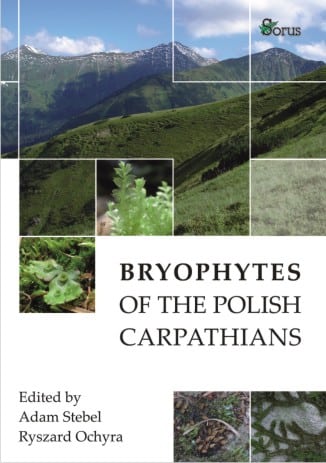Opis
Książka jest kontynuacją zainicjowanej w 2004 r. nieformalnej serii prac briologicznych Wydawnictwa Sorus poświęconych różnym aspektom badań mszaków Karpat.
Tom zawiera 22 artykuły należące do czterech grup tematycznych. Pierwsza z nich obejmuje opracowania brioflorystyczne, w tym obszerne i pełne flory mchów Kotliny Żywieckiej i Małych Pienin oraz wątrobowców i glewików Skalic Nowotarskich i Spiskich. Dopełnieniem ich są doniesienia florystyczne z Tatr oraz ze wschodniej części polskich Karpat.
Kolejnych 13 artykułów poświęconych jest rzadkim i zagrożonym gatunkom oraz rodzajom mchów i wątrobowców w Karpatach Zachodnich i na przyległym niżu. Trzy z nich dotyczą chronionych gatunków mchów Buxbaumia viridis i Dicranum viride. W pozostałych przedstawione jest aktualne rozmieszczenie oraz nowe stanowiska rzadkich w Karpatach gatunków, m.in.Campylopus subulatus, Brachydontium trichodes, Fissidens fontanus, Frullania tamarisci oraz dwóch gatunków z rodzaju Hymenoloma lub mających tam jedyne w Polsce stanowiska (Hygrohypnum alpinum, Cynodontium gracilescens). Ponadto zestawione zostały nowe stanowiska Orthodicranum tauricum – gatunku, który w ostatnich latach wyraźnie rozszerza swój zasięg w naszym kraju, oraz górskiego gatunku Andreaea rupestris w północno-wschodniej Polsce.
Problematyka taksonomiczna poruszona jest w pracy opisującej nowy dla nauki monotypowy rodzaj mchu Hylocomiadelphus, obejmujący H. triquetrus, gatunek dotychczas zaliczany do rodzajuRhytidiadelphus.
Ostatnia grupa tematyczna obejmuje dwie publikacje fitosocjologiczne, poświęcone zbiorowiskom zdominowanym przez mchy na torfowisku wysokim w Kotlinie Żywieckiej oraz fitocenozomPogonatum urnigerum i Oligotrichum hercynicum na antropogenicznych siedliskach w polskich Karpatach.
The book consists of 22 articles which can be divided into several thematic groups. The fi rst three papers are fairly voluminous because they take the form of local moss fl oras of the Kotlina Żywiecka Basin (A. Stebel) and Małe Pieniny Range (R. Ochyra and A. Stebel) and a liverwort and hornwort fl ora of the Skalice Nowotarskie and Spiskie klippen (R. Ochyra and B. Cykowska). This fl oristic part of the book is supplemented by three smaller accounts on the mosses of the eastern part of the Polish Carpathians (L. Armata) and the liverworts (H. Klama) and bryophytes (B. Cykowska) of the Tatra Mountains.
The next 13 articles deal with individual species and genera of mosses and liverworts which are rare or otherwise phytogeographically interesting. Most of them consider the distribution of these taxa in the Polish Carpathians; among the species concerned are Campylopus subulatus and Brachydontium trichodes (A. Stebel), Frullania tamarisci (R. Zubel and A. Stebel), Fissidens fontanus (J. Żarnowiec and L. Armata) and two species of Hymenoloma (R. Ochyra, A. Stebel and H. Bednarek-Ochyra). The other two accounts deal with species which have their only Polish occurrences in the Carpathians, namely Cynodontium gracilescens (R. Ochyra, A. Stebel and H. Bednarek-Ochyra) and Hygrohypnum alpinum (J. Żarnowiec and L. Armata). The Polish rarity and protected moss Buxbaumia viridis was rediscovered in the Pieniny (G. Vončina) and at six stations in the Polish Western Carpathians (B. Cykowska), while for the European threatened moss Dicranum viride new records in Poland are given including some new recent records from the Carpathians (A. Stebel, J. Żarnowiec, B. Cykowska and M. Szczepański). The doubtful occurrence of Jungermannia exsertifolia subsp. cordifolia, a taxon once reported from the Carpathians at its single locality in Poland, is discussed and it is defi nitely excluded from the known hepatic fl ora of the country (R. Zubel). The granite moss Andreaea rupestris, which is common in the alpine belt in the Tatras, occurs rarely in the northern Polish lowlands at relict stations on granitic blocks and its current distribution in north-eastern Poland is reviewed (M. Szczepański).
Finally, the present-day distribution of Orthodicranum tauricum, a species which is rapidly spreading in Poland, is given in this section (A. Stebel, R. Ochyra, S. Wierzcholska, B. Fojcik, A. Rusińska, S. Rosadziński and M. Szczepański).
Moss taxonomy is represented in the book by a single paper in which Hylocomiadelphus is described as a new moss genus for a species which has long been known as Rhytidiadelphus triquetrus and which is widespread in the Polish Carpathians (R. Ochyra and A. Stebel).
The two fi nal papers are phytosociological accounts. The fi rst of these describes the plant community Sphagno fallacis-Eriophoretum vaginati in the Kotlina Żywiecka Basin (P. Nejfeld). The second, bringing the book to an end, deals with phytocoenoses of Pogonatum urnigerum and Oligotrichum hercynicum in the Polish Carpathians (P. Górski).














Opinie
Na razie nie ma opinii o produkcie.